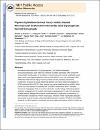Pigment epithelium-derived factor inhibits retinal microvascular dysfunction induced by 12/15-lipoxygenase-derived eicosanoids

التاريخ
2015-03المؤلف
Ibrahim, Ahmed S.Tawfik, Amany M.
Hussein, Khaled A.
Elshafey, Sally
Markand, Shanu
Rizk, Nasser
Duh, Elia J.
Smith, Sylvia B.
Al-Shabrawey, Mohamed
...show more authors ...show less authors
البيانات الوصفية
عرض كامل للتسجيلةالملخص
We recently demonstrated that 12/15-lipoxygenase (LOX) derived metabolites, hydroxyeicosatetraenoic acids (HETEs), contribute to diabetic retinopathy (DR) via NADPH oxidase (NOX) and disruption of the balance in retinal levels of the vascular endothelial growth factor (VEGF) and pigment epithelium-derived factor (PEDF). Here, we test whether PEDF ameliorates retinal vascular injury induced by HETEs and the underlying mechanisms. Furthermore, we pursue the causal relationship between LOX–NOX system and regulation of PEDF expression during DR. For these purposes, we used an experimental eye model in which normal mice were injected intravitreally with 12-HETE with/without PEDF. Thereafter, fluorescein angiography (FA) was used to evaluate the vascular leakage, followed by optical coherence tomography (OCT) to assess the presence of angiogenesis. FA and OCT reported an increased vascular leakage and pre-retinal neovascularization, respectively, in response to 12-HETE that were not observed in the PEDF-treated group. Moreover, PEDF significantly attenuated the increased levels of vascular cell and intercellular adhesion molecules, VCAM-1 and ICAM-1, elicited by 12-HETE injection. Accordingly, the direct relationship between HETEs and PEDF has been explored through in-vitro studies using Müller cells (rMCs) and human retinal endothelial cells (HRECs). The results showed that 12- and 15-HETEs triggered the secretion of TNF-α and IL-6, as well as activation of NFκB in rMCs and significantly increased permeability and reduced zonula occludens protein-1 (ZO-1) immunoreactivity in HRECs. All these effects were prevented in PEDF-treated cells. Furthermore, interest in PEDF regulation during DR has been expanded to include NOX system. Retinal PEDF was significantly restored in diabetic mice treated with NOX inhibitor, apocynin, or lacking NOX2 up to 80% of the control level. Collectively, our findings suggest that interfering with LOX–NOX signaling opens up a new direction for treating DR by restoring endogenous PEDF that carries out multilevel vascular protective functions.
معرّف المصادر الموحد
http://www.sciencedirect.com/science/article/pii/S1388198114002765المجموعات
- العلوم الصحية - كلية الآداب والعلوم (قبل 2016) [151 items ]


